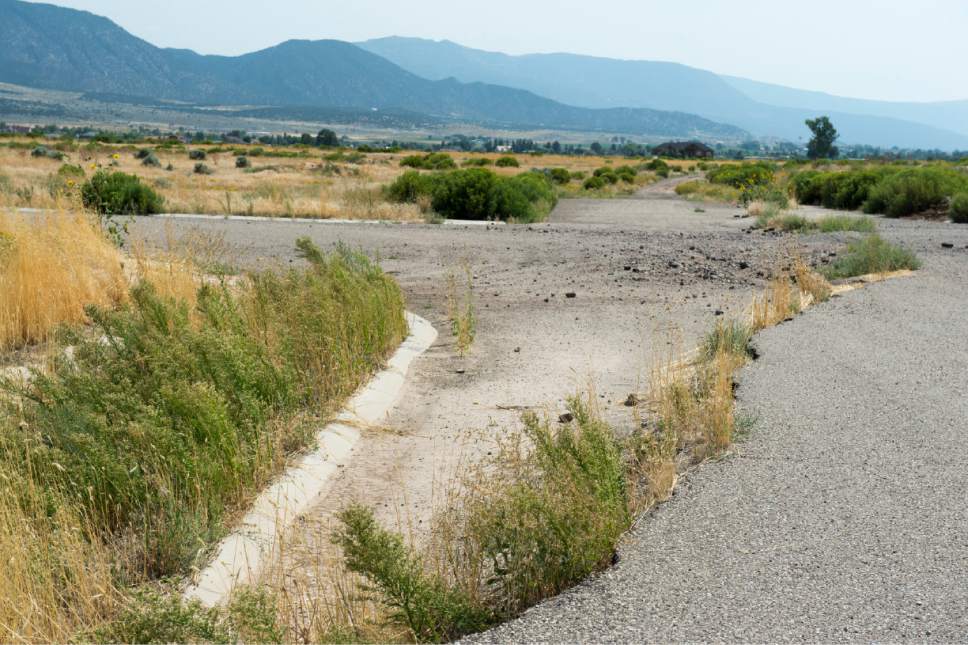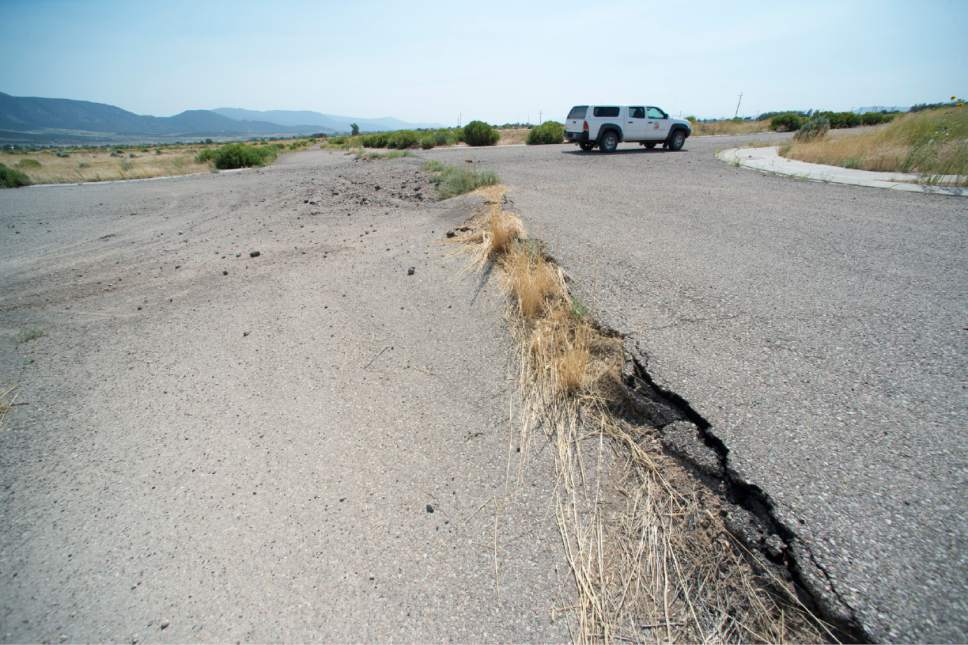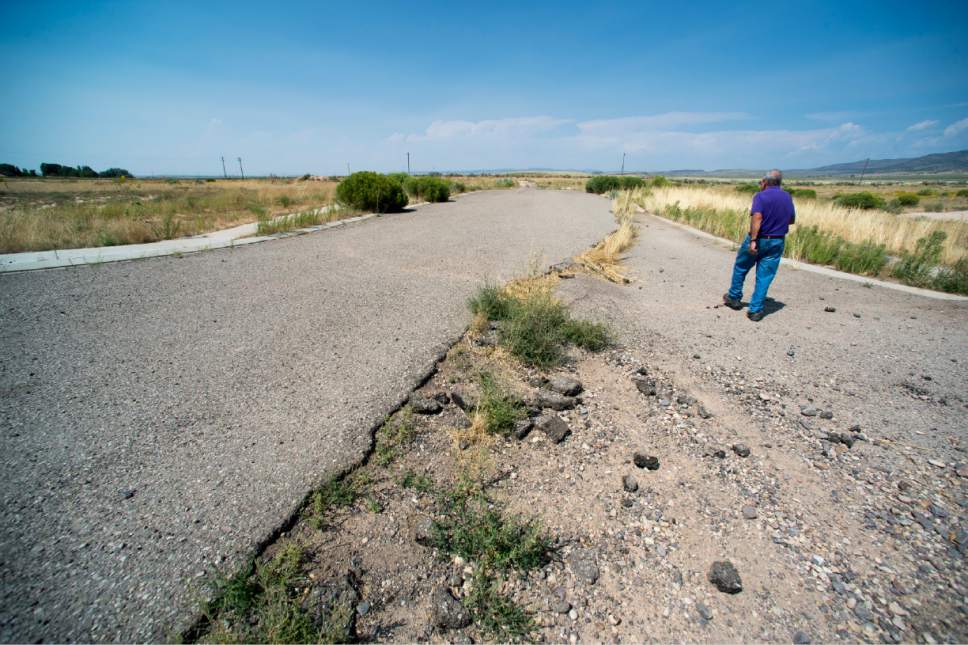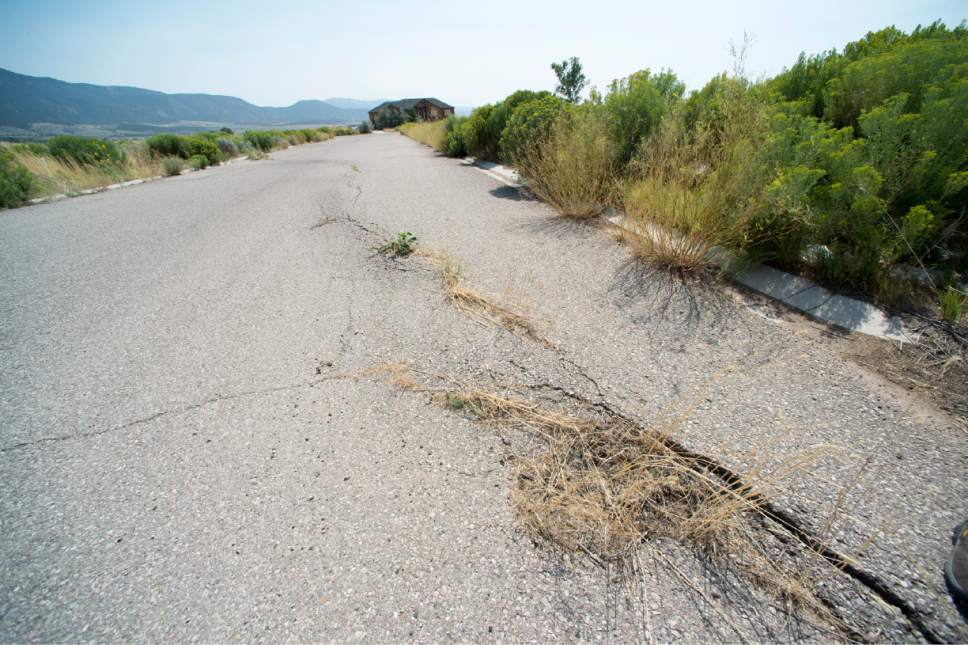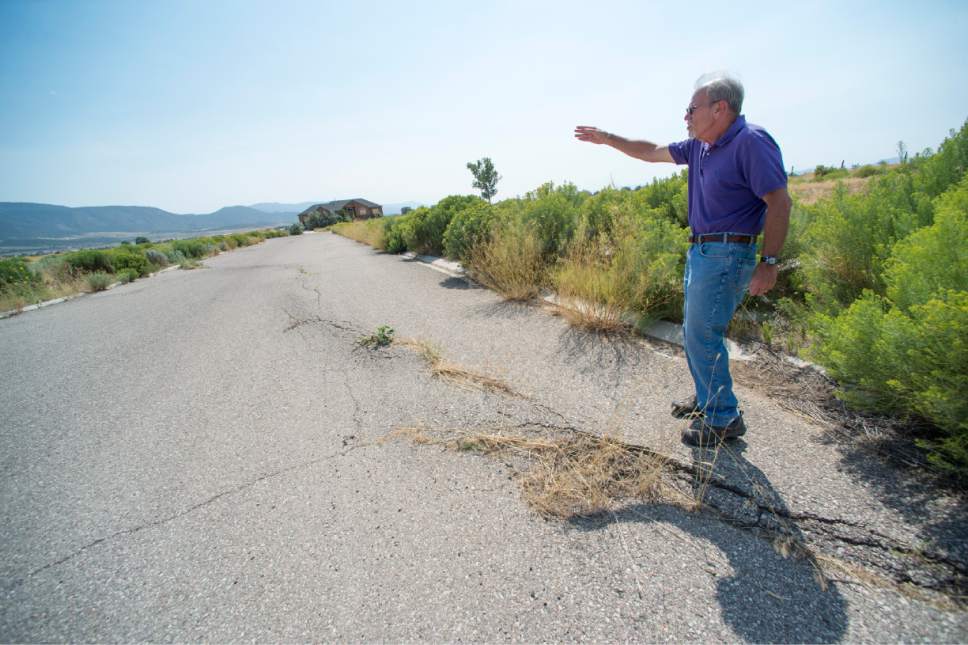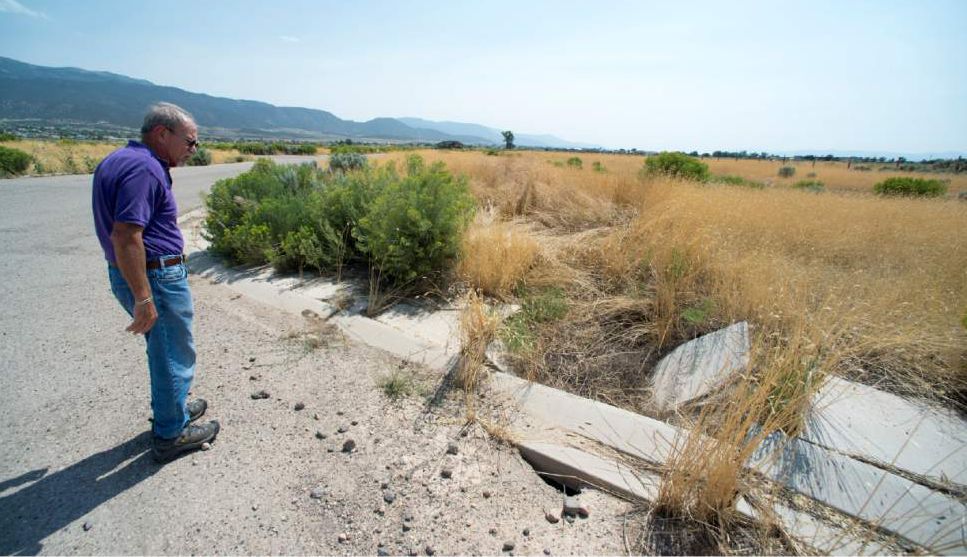This is an archived article that was published on sltrib.com in 2015, and information in the article may be outdated. It is provided only for personal research purposes and may not be reprinted.
Enoch • At the northern end of a small but rapidly growing southern Utah community lies a modern ghost town.
Marketed less than a decade ago as the Cedar Valley's most desirable up-and-coming community, the $12 million Parkview subdivision saw only one house erected. The structure sits alone, ruined and vacant, at the end of a broken road that leads nowhere. Even as new development springs up elsewhere in Enoch, the only thing that ever moved into Parkview was a ground fissure.
The 8-mile-long crack in the ground, though visually and anecdotally dramatic, is just a symptom of a wider, invisible problem. The water table beneath the Cedar Valley is falling, geologists say, causing the ground above it to collapse.
And seven years after the fissure opened, the community is still debating how the region's booming economy and population can be reconciled with this mysterious human-made geological hazard.
—
Broken dreams • As the housing market soared in the early 2000s, Pat Burns approached friend and business partner David LeBaron about his dream to build a high-end development with an eye toward the great outdoors.
"The market was incredible, and we weren't building a regular run-of-the-mill subdivision. … It was going to be the nicest subdivision in the Cedar City area, that's for sure," said Burns, then the owner of PP&D Construction. "We wanted to make a good project and make a good name for ourselves."
LeBaron, whose family owned land in Enoch, liked the idea and signed on as the Parkview developer. PP&D would oversee the construction.
"The vision," LeBaron said, "was creating a unique subdivision with open spaces, a new unique project for Enoch City."
The development would be comprised of standard quarter-acre building lots, but each would have direct access to a large, open space — baseball diamonds, parks and playgrounds, even a reservoir for fishing. Parkview would be the ideal home for families who wanted easy access to outdoor recreation but didn't want the maintenance that comes with having a large piece of property.
With land prices climbing one month over the next, Burns said, they had several offers on Parkview, but turned would-be buyers away without a second thought. Plenty of potential residents were lined up to buy vacant lots appraised at $90,000 a piece, so it seemed they had far more to make by forging ahead themselves.
But, in early 2008, just as the first phase of Parkview was nearly ready to hit the market, construction hit a snag. The completion of the sewer system was delayed for several months, stalling the buyers who had committed to buy more than half the subdivision, LeBaron said.
Then the market failed. The banks that held the Parkview loans were shut down by the Federal Deposit Insurance Corp. And just like that, lots once valued at $90,000 were going for less than $30,000.
Enter Jay Eubanks, the sole Parkview buyer who managed to get a home built. Sort of.
Burns said he met Eubanks via an investor group. Burns had pitched the group on Parkview, a chance to purchase prime property at a steep discount, fund the construction of a new home, and walk away with a tidy profit when the sale was complete.
All this sounded like a good way to make a quick buck, said Eubanks, who said he met Burns after his brother told him about the Parkview investment opportunity.
"I honestly thought I could profit $80,000 to $100,000 on this," said Eubanks, a network administrator who lives in Salt Lake City.
He was told the house would be finished in three or four months, he said, and got a short-term loan to finance the construction. But when it came due, the house wasn't ready — it didn't have an occupancy permit.
It wasn't until the end of January 2009, Eubanks said, that he discovered the reason his house couldn't get an occupancy permit — it had no sewer service.
The builder, Eubanks said, "had gone behind my back" and, to get a building permit, signed a waiver acknowledging the lack of sewer service.
Burns said Eubanks was aware of the waiver — signed in May 2008 by a PP&D Construction foreman — but it wasn't a big deal at the time. No one really thought the sewer would remain unfinished forever.
"That was never even a thought," Burns said. "We didn't see this happening — we had invested millions."
Eubanks tried to sue, Burns said. The suit was unsuccessful, he said, because by that time Burns, too, had lost everything, including his own house.
Unable to pay off the original short-term loan, Eubanks took out a mortgage on his finished, but nonfunctioning, investment home.
Then the fissure opened.
—
An unstable foundation • Bill Lund, a scientist with the Utah Geological Survey who studies geologic hazards, took a walk through Parkview in August to survey the scenery.
"This is actually considerably worse than the last time I was out here in March," he said, pointing out barely navigable roads and sinkholes that have swallowed up segments of sidewalk.
Lund first visited Parkview's fissure in 2009, when the Utah Geological Survey got a call from officials in Enoch. The city had sent an employee to check out the roads, water lines, sewer and such in a routine inspection municipalities conduct before assuming responsibility for utilities.
The inspector noticed something unusual — cracking pavement.
"We know there are faults through Enoch, so we went to check it out," Lund said. "But we recognized at once that we weren't looking at a fault."
It was a fissure — a literal crack in the earth.
Lund and his colleagues spent the next several years monitoring and studying the fissure. They published a 120-page report on the topic in 2014, concluding that Cedar Valley had a far bigger problem than a couple of cracked roads.
The Cedar Valley, Lund said, is like a big mountain-rimmed bowl that in a past geologic age filled up with sediment, loose silt and clay, that's capable of holding a lot of water.
Fissures develop when human-made wells meet a certain kind of groundwater aquifer. Most people think of aquifers as giant underground lakes, Lund said, but the water in the Cedar Valley aquifer is mixed with the valley's silty clay, giving a buoyancy to the terra firma beneath residents' feet. Withdrawing too much water causes the sediment to compact, and the valley floor above the aquifer to sink.
The Cedar Valley is exceeding this aquifer's capacity for pumping by about 9,000 acre-feet per year, Lund said. And the results are stark: The elevation of the Cedar Valley is decreasing by an estimated rate of 0.02 to 1.2 inches per year.
This gradual subsidence can cause fissures to develop around the rim of the "bowl" where the valley floor separates from the mountains that surround it. The Parkview fissure was measured by UGS to be almost 3 feet high in some places and is probably hundreds of feet deep below the surface. That kind of displacement didn't just happen overnight in 2009.
"The escarpment is clearly visible ... in historical aerial photographs dating back to at least the 1990s," said Tyler Knudsen, the lead author on the UGS study. "In 2009, when we followed the fissure northward beyond grading for the development, the escarpment was 1 to 2 feet high and quite obvious."
One of the first things Lund did when they initiated the fissure study was look up Enoch City on Google Earth, where the fissure is plainly visible.
Lund said it's bewildering that anyone managed to develop land and build roads across the fissure without noticing it.
"They had a consultant, they had a geotechnical engineer who I wouldn't hire to pontificate in the street after this," Lund said. "His name shall remain forever off my lips, but I think he screwed them."
The final geotechnical study, completed by GEM Engineering in 2005, said nothing about subsidence or fissures and OK'd the area for development.
Requests for comment from GEM Engineering, based in Cedar City, were referred to the company's legal counsel, who after initially stating that he was not familiar with Parkview or the fissure, did not return multiple calls from The Salt Lake Tribune.
Knudsen said the property's proximity to known earthquake faults should have raised red flags about development no matter what.
But fissures are new to Utah — the Parkview fissure is the first in Utah to have interfered with the urban environment — so, Knudsen said, a local consultant might have known nothing about them.
—
Farmers sometimes know • Unlike most other geologic hazards, fissures are almost entirely human-made — someone has to pump the water out of a sensitive aquifer before a fissure will occur. Consequently, scientists actually know little about fissures — how to detect them, how to predict where they might develop, or what to do to remediate existing fissures.
Even Arizona, where fissures were first detected in 1929, has yet to develop guidelines for building in subsidence-prone areas, said Michael Conway, chief of the Geologic Extension Service in Arizona. He's hesitant to place blame on those involved in the Parkview development.
"If there was no evidence of earth fissures in the past, I don't know what these people could have done that would have helped them out," he said. "It's very difficult to know that fissures are actually there."
What scientists do know, Conway said, is that new fissures often appear when valleys that once hosted a large agricultural base are urbanized.
"All of the fissures here in Arizona are associated with agriculture," he said. "It doesn't bother farmers too much, but when you start to urbanize the area, that's where we run into issues."
Arizona has developed a two-pronged approach to monitoring fissures, Conway said. Because fissures tend to cluster together, known fissures are mapped and monitored for growth. And the state solicits information from residents — especially farmers, who often know about the fissures long before anyone else notices.
That kind of a program might have helped developers in Enoch, where a cluster of farmers reported strange cracks in their fields to the UGS.
One told Lund he even had tried to warn off developers.
"We went and spoke to a crusty farmer up the road," Lund said, "and he goes, 'You know, I told those fools, I told them there was a fissure down there, and they wouldn't pay attention to me.' "
Knudsen said he too was told by farmers that they tried to tell Parkview developers about the fissures. But if they did in fact inform someone, they didn't reach the right people. Burns and LeBaron said they knew nothing about the possibility of a fissure in the area until the fissure made the news in 2009.
Burns said he, too, spoke to farmers who said they were aware that something was wrong, but not until after 2009.
"I actually talked to an old farmer, a year or so ago, and he goes 'Oh, yeah, we knew the fissure was there,' " he said. "And I said, 'Oh, really? You probably should have told someone.'… It could have been a huge nightmare if we had put in a couple of homes and then the fissure happened."
Today, the fissure's direct path through 11 of Parkview's once-high-priced lots is plainly visible.
"And I say, good thing the economy crashed in 2008," Lund said, "because otherwise there would be 11 people here with a serious issue."
The fact that the fissure caused less damage than it could have is little comfort to the people who did see catastrophic losses.
After months of making payments on a second mortgage, Eubanks found an expert and attempted to recoup anything he could with a short sale. The home, originally valued at $332,000, was listed for $50,000. Even at that price, when buyers found out about the fissures, "nobody would touch it," he said.
The credit union repossessed the property and credited him $80,000, the estimated value of the house. But he was still on the hook for the remaining value of the loan — $200,000 — and had to file for bankruptcy.
Looking back, Eubanks said, he wishes he had paid more attention to the red flags. "The community should learn the same thing that I learned," he said. "We should be a little more thorough in our evaluation of property before deciding it is suitable for investment."
—
Boom town • Scientists can't predict where fissures will form or what path they might take — even if there's one right next door, Conway said. But if there's one fissure in Cedar Valley, there's likely to be more.
The only real solution, he said, is to stop fissure growth by ending aquifer drawdown. There are fissures in Arizona that stopped growing when the amount of water pumped out of the aquifer decreased. Oftentimes, he said, this is a natural result of urbanization — subdivisions use a lot less water than farms, and so when homes replace farms, water use declines.
But that's not happening in Enoch City, where agriculture is not only thriving but growing. That means the community is going to need to come together to find a way to conserve water, said Rob Dotson, city manager of Enoch City.
The Central Iron County Water Conservancy District has plans to build a 50-mile, $150 million pipeline to bring in water from an aquifer in Pine Valley, but Dotson believes that's just a stopgap.
"Around here ... everybody just acts like there's going to be enough [water] for everything, and it's no big deal," he said. "But long-term, there's some problems. We can either be forced into having a conservation plan, or we can come up with our own and fix it before they have to."
Enoch City has also implemented strict rules about what must happen before any further development can happen in Parkview.
Those who wish to develop the still-vacant lots must not only build up their lot in a way that addresses the fissure, but also devise a plan that gets the entire subdivision back online by rerouting the roads and all essential services around the fissure.
The Parkview subdivision was sold in parcels at a tax auction to diverse owners, and no one has yet taken up the city on the offer.
LeBaron's not surprised. With this newfound knowledge of subsidence in Cedar Valley, he said, development should proceed with caution.
"It just doesn't work to develop homes in an area where there's the potential for this much ground movement; I just don't think it's wise."
The old-timers in town, Dotson said, hold that fissures aren't a new problem, aren't hurting anything, and that there's no real reason for concern. But newcomers seem to agree with LeBaron's view.
"Even now, with the market booming, those lots around [Parkview] are half the price of other lots," Burns said, "because somebody wrote about the fissure."
Dotson said real estate deals throughout the city have failed when the potential buyers heard about the UGS study and the fissure.
"That's where studies can be a real mess," he said. "People start talking about this fissure and how it's horrible and how it's so detrimental to our whole way of being and water is being over-pumped and, 'Oh no, it's a disaster,' and then people start reacting. They start protecting and they stop investing.
"People have come to me and said, 'What can we do about this?' and I say, 'Well, ignore the study. Don't bring it up.' And that might be irresponsible, but if you go the other direction, they start talking about the study, and then people will not invest."


